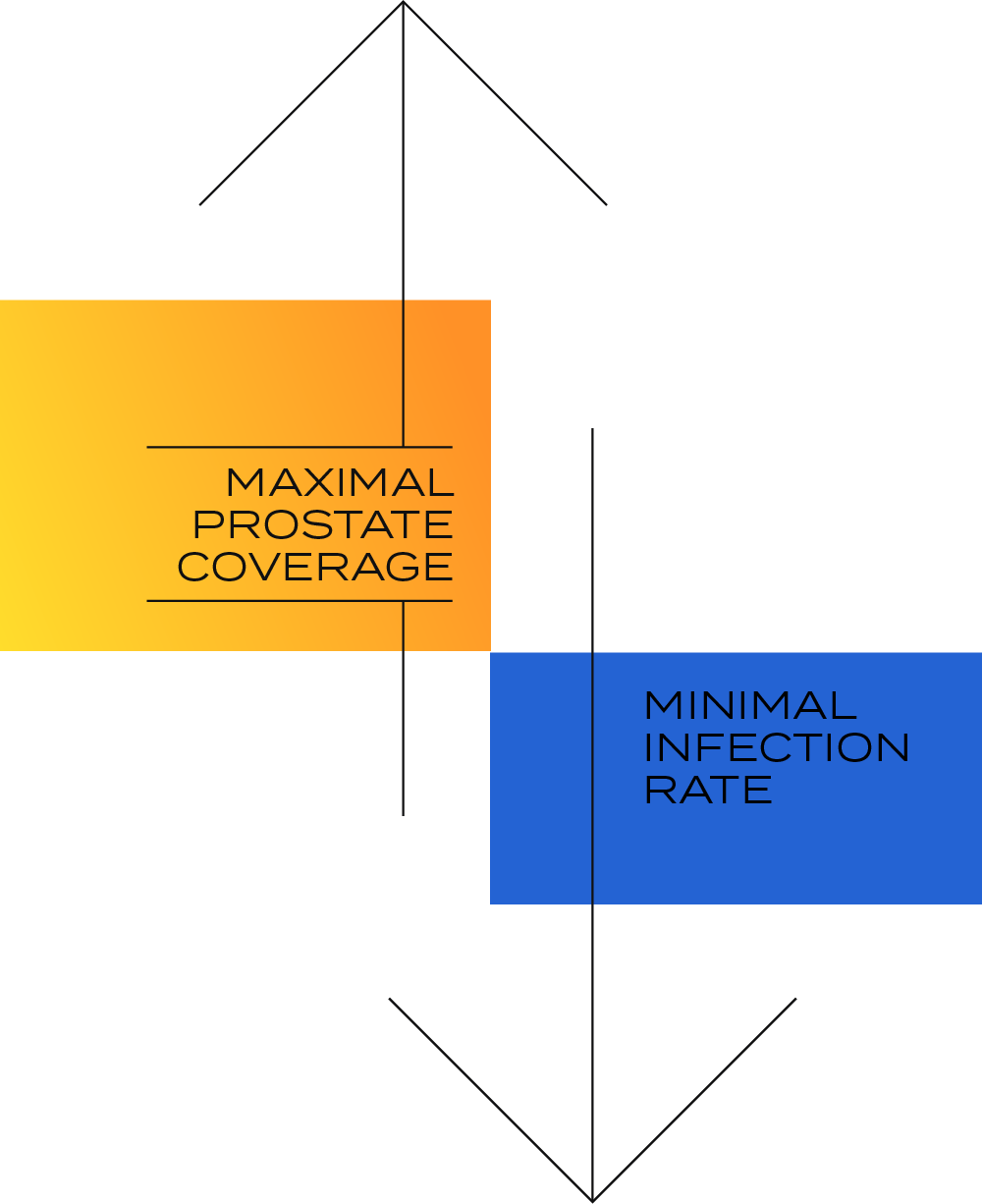
A New Era in Prostate Care
The landscape of prostate biopsies is undergoing transformative changes. In Europe, the European Association of Urology now strongly recommends transperineal over transrectal biopsies. 1
In the US, leading Centers of Excellence including the Mayo Clinic are also recommending transperineal biopsies. 2
Robotics will be essential to delivering this new gold standard for patients.
The Challenge
with the Status Quo
Traditional transrectal prostate biopsies carry significant drawbacks:
High infection risk
- 3–5% infections 3,4
- 6.9% 30-day re-admission rate 5
- 4-fold increase in hospital admissions over a 10-year period 6
Underdiagnosis
- Traditional ultrasound biopsies only detect 23% of clinically significant cancers 7

The New Standard of Care:
Transperineal Biopsies
To address these issues, the standard of care is shifting to transperineal biopsies, and utilizing MRI+ultrasound fusion guidance to provide better visualization and maximal prostate coverage.
However, these manual transperineal biopsies pose a steep learning curve 8 for urologists, potentially hindering widespread adoption.
The Robotic Advantage
Robotic-controlled needle positioning offers urologists the precision needed for transperineal procedures, ensuring:
![Robotic_Advantage A 3/4 frontal view photo of Mona Lisa 2.0 [TX] robot.](https://biobotsurgical.com/wp-content/uploads/2024/02/Robotic_Advantage.png)
01
Higher accuracy in cancer detection 9
02
Virtually zero infection risk 10
03
Less invasive tissue sampling
Mona Lisa
- Diagnostic evaluation guidelines, EAU: https://uroweb.org/guidelines/prostate-cancer/chapter/diagnostic-evaluation.
BaturaD, Rao GG. The national burden of infections after prostate biopsy in England and Wales: a wake-up call for better prevention. J AntimicrobChemother2013;68:247–9. - https://www.mayoclinic.org/medical-professionals/urology/news/ultrasound-guided-transperineal-prostate-biopsy/mac-20473283
- Pradere B, Veeratterapillay R, Dimitropoulos K, et al. Nonantibiotic Strategies for the Prevention of Infectious Complications following Prostate Biopsy: A Systematic Review and Meta-Analysis. J Urol. 2021;205(3):653-663. https://pubmed.ncbi.nlm.nih.gov/33026903/.
- Loeb S, Carter HB, Berndt SI, Ricker W, Schaeffer EM. Complications after prostate biopsy: data from SEER-Medicare. J Urol2011; 186: 1830–1834.
Nam RK, SaskinR, Lee Y etal. Increasing hospital admission rates for urological complications after transrectalultrasound guided prostate biopsy. J Urol 2010; 183: 963–968. - Valerio, M., Donaldson, I., Emberton, M., Ehdaie, B., Hadaschik, B. A., Marks, L. S., Mozer, P., Rastinehad, A. R., & Ahmed, H. U. (2015). Detection of Clinically Significant Prostate Cancer Using Magnetic Resonance Imaging-Ultrasound Fusion Targeted Biopsy: A Systematic Review. European urology, 68(1), 8–19.
- Halstuch D, Baniel J, Lifshitz D, Sela S, Ber Y, Margel D. Characterizing the learning curve of MRI-US fusion prostate biopsies. Prostate Cancer Prostatic Dis. 2019;22(4):546-551. DOI: 10.1038/s41391-019-0137-2.
- Patel MI, Muter S, Vladica P, Gillatt D. Robotic-assisted magnetic resonance imaging ultrasound fusion results in higher significant cancer detection compared to cognitive prostate targeting in biopsy naive men. Transl Androl Urol. 2020;9(2):601-608.
- Patel, A. & Servian, P. & Winkler, Mathias & Tiong, L.C. & Yuen, John & Ho, Hey & Chen, Kenneth & Kruck, S. & Grummet, Jeremy. (2017). Robotic MRI/US fusion transperineal biopsy using the iSR’obot Mona Lisa: Technique, safety and accuracy. European Urology Supplements. 16. e2092-e2093.
- Patel MI, Muter S, Vladica P, Gillatt D. Robotic-assisted magnetic resonance imaging ultrasound fusion results in higher significant cancer detection compared to cognitive prostate targeting in biopsy naive men. Transl Androl Urol. 2020;9(2):601-608.
- Patel, A. & Servian, P. & Winkler, Mathias & Tiong, L.C. & Yuen, John & Ho, Hey & Chen, Kenneth & Kruck, S. & Grummet, Jeremy. (2017). Robotic MRI/US fusion transperineal biopsy using the iSR’obot Mona Lisa: Technique, safety and accuracy. European Urology Supplements. 16. e2092-e2093.